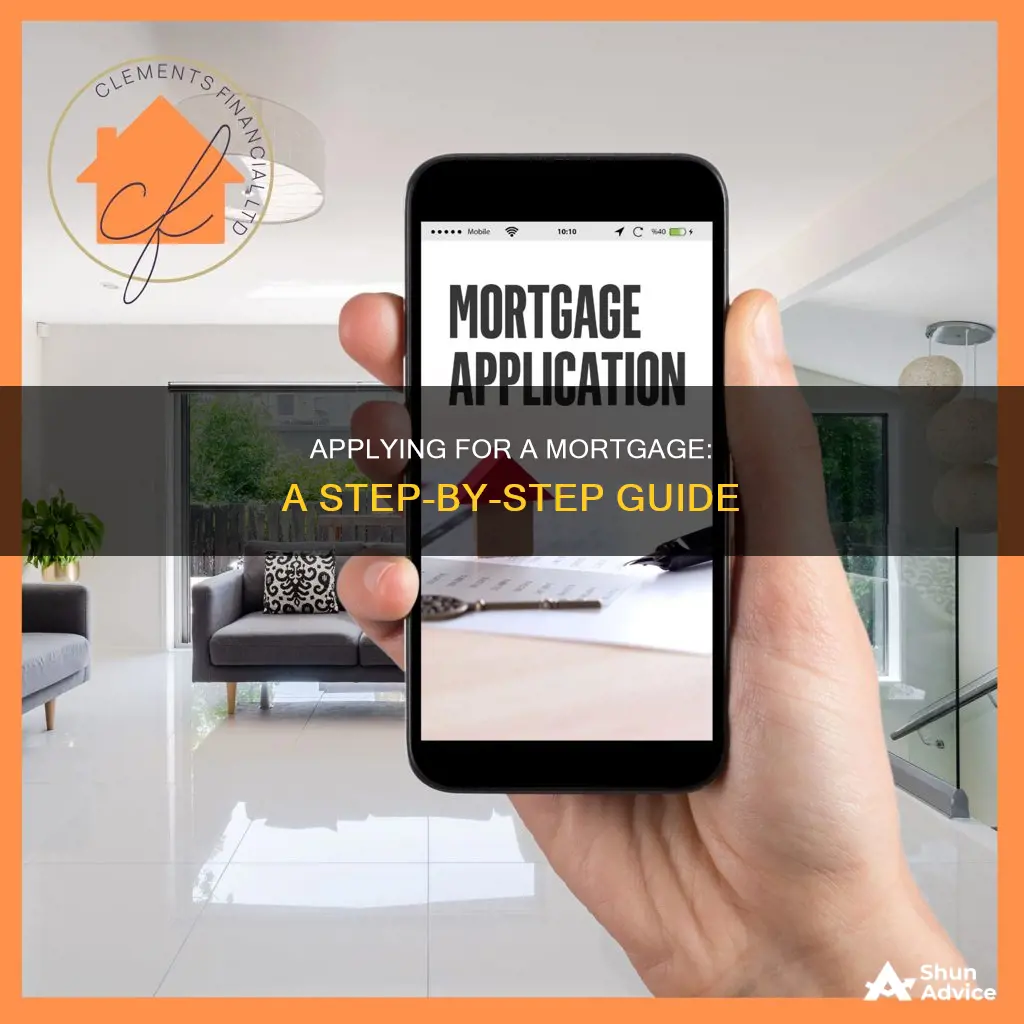
Applying for a mortgage can be a daunting process, but with careful preparation, you can increase your chances of approval and secure a favourable deal. Before applying, it is important to review your credit report, which can be accessed for free from Experian, Equifax and TransUnion. A higher credit score indicates a greater likelihood of approval and more favourable rate offers. Once you have found a suitable home, you will need to select a lender and complete an application, which may be done in person, by phone or online. All lenders will require you to provide information about yourself and any co-borrowers, as well as documentation to verify your financial situation. To get a sense of how much money you can borrow, you can apply for preapproval, which is typically valid for 60 to 90 days. It is worth shopping around and comparing different lenders to find the best rates and terms for your mortgage.
| Characteristics | Values |
|---|---|
| Time taken | 43 days on average, but can be anywhere from two weeks to two months |
| Steps | Research lenders and compare rates, get preapproved, house hunt, apply for the mortgage |
| Application process | Choose a lender and loan, submit paperwork, loan processing and underwriting, close on your loan |
| Application methods | In person, by phone, or online |
| Application information | Personal information, employment and income details, assets and liabilities, credit history, property information |
| Additional documentation | Down payment funds, cash reserves to cover the first few months of mortgage payments, documents specific to your situation |
| Closing costs | 2% to 6% of the loan amount, including appraisal fees, attorney fees, credit report fees, title search fees, and property inspection fees |
| Credit score | Minimum of 680 for a conventional mortgage, lower for other types of loans |
What You'll Learn

Compare mortgage types and lenders
When comparing mortgage types and lenders, it's important to do your research and understand your own financial situation and goals. Here are some key things to consider:
Mortgage Types
Firstly, you should understand the different types of mortgages available. The two main types are fixed-rate and adjustable-rate mortgages. A fixed-rate mortgage offers more certainty, with a stable interest rate for the life of the loan, which can provide peace of mind as you'll know exactly what your monthly payments will be. Adjustable-rate mortgages, on the other hand, have fluctuating interest rates that can result in lower initial payments but may increase over time, impacting your monthly payments. Other types of mortgages include conventional, FHA, VA, and USDA loans, each with its own pros and cons. For example, FHA loans are easier to qualify for but may require mortgage insurance and cost more overall, while VA and USDA loans require no down payment.
Lenders
There are several types of mortgage lenders, including banks, credit unions, online banks, and mortgage brokers. Banks are the most common type of lender and typically offer a range of home loans to meet different needs. If you already have accounts with a national bank, getting your mortgage from the same place can be convenient for account management. Credit unions are non-profit and owned by their members, offering a more personalised experience, but you must be a member to access their services. Online-only lenders may offer low-interest rates and many loan options, but they may not provide the same level of personalised service as traditional lenders. Mortgage brokers don't lend money directly but can shop around for the best terms from multiple lenders, saving you time and helping you find a loan that fits your specific needs.
Interest Rates and Fees
When comparing lenders, consider the interest rates and fees they charge. A higher credit score can often lead to a lower interest rate, as it demonstrates to lenders that you're a low-risk borrower. Ask lenders for the annual percentage rate (APR), which includes both the interest rate and any associated fees. Also, consider the loan term, as longer terms typically come with higher interest rates, while shorter terms have lower rates. Be sure to get a detailed breakdown of all fees, as these can impact the overall cost of the mortgage. Some fees may be negotiable, so understanding what each fee covers can help you get better terms.
Programs and Special Offers
Different lenders may offer special programs or grants, especially for first-time homebuyers. These programs can provide assistance with closing costs or down payments. It's worth researching and comparing these offerings to see if you qualify for any benefits that can make your mortgage more affordable.
Research and Recommendations
Before reaching out to lenders, research them online to understand their offerings and specialisations. Check their licensing status and customer reviews to ensure they are reputable and well-established. You can also ask for recommendations from friends, family, or your real estate agent to get insights on their experiences with different lenders.
Incorporate Closing Costs: Folding Them into Your Mortgage
You may want to see also

Get pre-approval and pre-qualification
Mortgage prequalification is an early step in the home-buying process. It is a quick and simple process that provides an estimate of how much you might be able to borrow from a lender. It is based on a review of your income, assets, debts, and credit information. Prequalification can be done online, in person, or over the phone, and usually takes just a few minutes. It does not require any documents or fees, and it does not affect your credit score.
Mortgage prequalification is a good way to understand your options and make more informed decisions. It can help you focus your home search by providing a general estimate of what you can afford. It can also highlight any potential financial constraints, such as a high debt-to-income ratio, and improve your negotiating power by signalling to sellers that you are likely capable of borrowing a specific loan amount.
Mortgage preapproval, on the other hand, is a more formal and specific estimate of how much you could borrow. It requires completing a detailed application form and submitting documentation that backs your financial claims, such as proof of income (e.g. pay stubs or tax returns) and evidence of other financial assets (e.g. bank accounts, real estate holdings, or investments). Preapproval also requires consenting to a credit check and may require paying a fee. In return, the lender will provide a preapproval letter, which is an offer to lend you a specific amount, usually valid for 90 days. Submitting a preapproval letter along with your bid on a house can make your offer more attractive to sellers compared to other bidders who will require loan approval.
It is important to note that prequalification and preapproval are not guarantees that a lender will ultimately approve your loan application. However, they are both useful steps in the home-buying process, providing you with valuable information about your borrowing power and helping you stand out in a competitive market.
Discover Scorecard Mortgage: How Accurate Are These Assessments?
You may want to see also

Understand the application process
The mortgage application process can be complicated, but it can be broken down into six steps: pre-approval, house shopping, mortgage application, loan processing, underwriting, and closing.
Pre-approval
Pre-approval is when a lender assesses how much they are willing to lend you. They will look at your income, assets, credit, and interest rate to determine this. You can then use this figure to guide your home search and ensure you stay within budget. Pre-approval is not mandatory, but it can make your offer more attractive to sellers.
House shopping
Once you have pre-approval, you can start viewing properties and enlisting the help of a real estate agent.
Mortgage application
At this stage, your lender will ask you to fill out a full application and supply documentation relating to your income, debts, assets, and the home you are purchasing. They will also perform a credit check.
Loan processing
The lender will then review your application and provide you with a loan estimate, detailing the fees that will be charged at closing.
Underwriting
The mortgage underwriter is the key decision-maker in the mortgage approval process. They will check every aspect of your application and perform additional steps, such as ordering an appraisal of the property to determine if the funds from the sale will cover the mortgage amount. The underwriter will then decide to accept, reject, or approve the loan with conditions.
Closing
The closing process can take 30 to 60 days to complete. During this stage, you will receive a Closing Disclosure, which outlines the detailed and final costs of your mortgage. You will then have a chance to ask any last-minute questions before signing on your loan.
Mortgage Prequalification: Is It Reliable?
You may want to see also

Provide the necessary documentation
When applying for a mortgage, you will need to provide documentation to verify your identity, financial situation, creditworthiness, and employment history. Here are the steps you can take to ensure you have the necessary documentation:
- Review your credit report: You can access free credit reports from major credit bureaus like Experian, Equifax, and TransUnion. Check your report for any errors and dispute any inaccuracies. A higher credit score increases your chances of mortgage approval and more favourable rate offers.
- Gather identification documents: Lenders typically require state-issued identification, such as a driver's license or passport.
- Provide proof of income: Lenders will request recent pay stubs (typically for the last 60 days) and federal tax returns for the previous two years. These documents verify your income and employment history.
- Submit financial statements: Gather your bank account statements, including savings and checking accounts. You may also need to provide investment account statements, such as retirement accounts, from the last quarter.
- Understand the loan application process: Familiarize yourself with the mortgage application process and the specific requirements of your chosen lender. Each lender may have slightly different documentation requirements, so it's important to review their guidelines carefully.
- Provide additional documentation if necessary: Depending on your circumstances and the type of mortgage you are applying for, your lender may require further documentation. For example, if you are self-employed or have complex income sources, you may need to provide additional financial records or tax forms.
Remember, providing accurate and complete documentation is crucial for a smooth mortgage application process. By taking the time to gather and review the necessary documents, you can increase your chances of a successful application and secure the financing you need to purchase your home.
Wells Fargo Mortgage: Understanding Your Rights and Claims
You may want to see also

Lock in your rate
Locking in your rate is a crucial step in the mortgage application process, especially in a rising rate environment. A mortgage rate lock is a commitment from your lender to offer you a specific interest rate for a set period, typically 30, 45, or 60 days, but sometimes longer. This lock ensures that your interest rate won't change between the offer and the closing of your loan, protecting you from higher rates that may occur during the lock period.
Here's a step-by-step guide to locking in your rate:
- Shop around: Compare rates from at least three to five lenders to find the best interest rate and terms for your mortgage. Review all the closing costs on each loan estimate to make an informed decision.
- Get pre-approved: Once you've found a suitable lender, get pre-approved for a home loan. This usually involves submitting financial documentation and personal information for the lender's review.
- Understand the lock period: Ask your lender about the available rate lock periods and whether there are any fees involved. Rate locks typically last for 30, 45, or 60 days, but some lenders may offer longer options for an additional fee.
- Lock in your rate: Once you are happy with the interest rate offered and have considered the lock period, you can lock in your rate. This step usually takes place after your initial loan application has been approved and before it's submitted for underwriting.
- Monitor your lock expiration date: Keep track of the date your rate lock expires. If your loan doesn't close before the lock period ends, you may have to pay a fee to extend it. The fee for extending a rate lock is typically a percentage of your loan amount.
- Be mindful of changes: Remember that your locked-in interest rate is dependent on the consistency of your loan application details. Any changes to your credit score, income, loan amount, or other application details may void your rate lock and result in a new interest rate.
- Consider a float-down option: If you're concerned about interest rates dropping after you've locked in your rate, ask your lender about a float-down option. This allows you to take advantage of lower rates during the lock period, but it usually comes with an additional cost.
Remember that rate locks aren't always free, and the cost may be baked into the rate you're offered. Carefully review the terms and conditions of your rate lock agreement to understand all associated fees and potential savings.
Zillow's Mortgage Estimates: Accurate or Misleading?
You may want to see also
Frequently asked questions
Preparation is key. Before applying for a mortgage, it is important to review your credit report and be aware of your credit score. You can access free reports from Experian, Equifax and TransUnion at AnnualCreditReport.com. It is also worth considering the type of mortgage that is right for you, such as a fixed or adjustable rate, and whether a conventional or government-guaranteed loan is best.
You will need to select a lender and complete an application. You can apply in person, by phone or online. You will need to provide information about yourself and any co-borrowers, including documentation to verify your employment history, creditworthiness and overall financial situation. This may include identification documents, pay stubs, tax returns, bank account statements and investment account statements.
A mortgage preapproval is when a lender agrees to loan you a specified amount of money to buy a home, subject to certain conditions. It is similar to a loan application but does not require you to provide a specific home you want to buy. A preapproval will usually be valid for 60 to 90 days.
It is worth shopping around and applying with multiple lenders to compare offers and find the lowest rate. Interest rates and fees vary from lender to lender, so it is important to research and compare different lenders.







